1) Which is not a major function of the kidney?
- a) regulation of blood ionic composition
- b) regulation of blood cell size
- c) regulation of blood volume
- d) regulation of blood pressure
- e) regulation of blood pH
Answer: b
b
2) This is the formation of a new glucose molecule.
- a) glycolysis
- b) gluconeogenesis
- c) glucosamine
- d) glucose
- e) calcitriol
b
3) Which of the following is a waste product normally excreted by the kidneys?
- a) urea
- b) glucose
- c) insulin
- d) cholesterol
- e) carbon dioxide
a
4) This is smooth dense irregular connective tissue that is continuous with the outer coat of the ureter.
- a) adipose capsule
- b) renal capsule
- c) renal hilus
- d) renal cortex
- e) renal medulla
b
5) The portion of the kidney that extends between the renal pyramids is called the
- a) renal columns
- b) renal medulla
- c) renal pelvis
- d) calyces
e) renal papilla
a
6) Which is the correct order of blood flow through the kidneys?
- a) renal artery > segmental artery > interlobular artery > peritubular capillaries > afferent arterioles
- b) interlobar arteries > arcuate arteries > glomerular capillaries > arcuate veins
- c) arcuate veins > arcuate arteries > glomerular capillaries > renal vein
- d) renal vein > segmental arteries > interlobar arteries > efferent arterioles
- e) interlobar veins > afferent arterioles > efferent arterioles > glomerular capillaries
b
7) Which is the correct order of filtrate flow?
- a) glomerular capsule, proximal convoluted tubule (PCT), nephron loop, distal convoluted tubule (DCT), collecting duct
- b) nephron loop, glomerular capsule, PCT, DCT, collecting duct
- c) ascending limb of loop, PCT, DCT, collecting duct
- d) collecting duct, DCT, PCT, collecting duct, glomerular capsule
- e) PCT, glomerular capsule, DCT, collecting duct, nephron loop
a
8) Which structure of the nephron reabsorbs the most substances?
- a) glomerular capsule
- b) nephron loop
- c) ascending limb
- d) collecting duct
- e) proximal convoluted tubule
e
9) This is the structure of the nephron that filters blood.
- a) glomerulus
- b) nephron loop
- c) ascending limb
- d) collecting duct
- e) renal tubule
a
10) This term means the return of substances into the blood stream from the filtrate.
- a) reabsorption
- b) filtration
- c) secretion
- d) excretion
- e) none of these choices
a
11) This is a nephron process that results in a substance in blood entering the already formed filtrate.
- a) reabsorption
- b) filtration
- c) secretion
- d) excretion
- e) none of these choices
c
12) Glomerular capillaries and podocytes together form the
- a) glomerular endothelial cells
- b) filtration membrane
- c) pedicels
- d) filtration slits
- e) slit membrane
b
13) This occurs when stretching triggers contraction of smooth muscle walls in afferent arterioles.
- a) glomerular filtration rate
- b) tubulomerular feedback
- c) myogenic mechanism
- d) renal autoregulation
- e) capsular hydrostatic pressure
c
14) This occurs when a substance passes from the fluid in the tubular lumen through the apical membrane, across the cytosol, and then into the interstitial fluid.
- a) paracellular reabsorption
- b) transcellular reabsorption
- c) apical reabsorption
- d) basolateral reabsorption
- e) active transport
b
15) The proximal convoluted tubules reabsorb what percentage of filtered water?
- a) 25%
- b) 50%
- c) 65%
- d) 80%
- e) 99%
c
16) Which of the following is NOT a way angiotensin II affects the kidneys?
- a) It increases GFR
- b) It can decrease GFR
- c) It enhances reabsorption of certain ions
- d) It stimulates the release of aldosterone
- e) None of these choices
a
17) Urea recycling can cause a buildup of urea in the
- a) renal capsule
- b) nephron loop
- c) ascending tubule
- d) renal medulla
- e) renal pelvis
d
18) Increased secretion of hydrogen ions would result in a(n) ______________ of blood ____________?
- a) increase, pressure
- b) decrease, volume
- c) increase, sodium levels
- d) decrease, pH
- e) increase, urea
d
19) Increased secretion of aldosterone would result in a(n) [dropdown 1] of blood [dropdown 2]?
Dropdown 1 choices:
a)decrease
b)increase
Dropdown 2 choices:
a)calcium levels
b)pH
c)potassium
d)sodium
e)volume
a,d
20) An analysis of the physical, chemical, and microscopic properties of urine is called
- a) urinalysis
- b) filtration study
- c) concentration study
- d) diuretic
- e) osmolarity
a
21) Water accounts for what percentage of the total volume of urine?
- a) 25%
- b) 50%
- c) 75%
- d) 80%
- e) 95%
e
22) This is a test to measure kidney function.
- a) Plasma creatinine
- b) Renal study
- c) Kidney assay
- d) Dialysis
- e) Hilus study
a
24) This layer of the ureter is composed of connective tissue, collagen and elastic fibers.
- a) Mucosa
- b) Transitional epithelium
- c) Lamina propria
- d) Adventitia
- e) Lamina elastica
c
23) This transports urine from the kidney to the bladder.
- a) Urethra
- b) Ureter
- c) Descending nephron loop
- d) Renal hilus
- e) None of these choices
b
25) This lies in the anterior corner of the trigone of the bladder.
- a) Urethral sphincter
- b) Adventitia bundle
- c) Ureter
- d) Internal urethral orifice
- e) Muscularis bundle
d
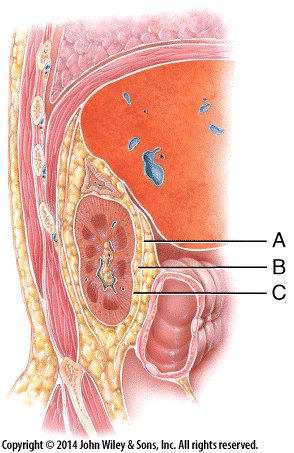
26) This is composed of dense irregular tissue that runs continuous with the ureter
- a) A
- b) B
- c) C
c

27) This layer’s main function is to protect the kidney from trauma and hold it in place within the abdominal cavity.
- a) A
- b) B
- c) C
b

28) This layer runs deep to the peritoneum on the anterior surface of the kidneys.
- a) A
- b) B
- c) C
a
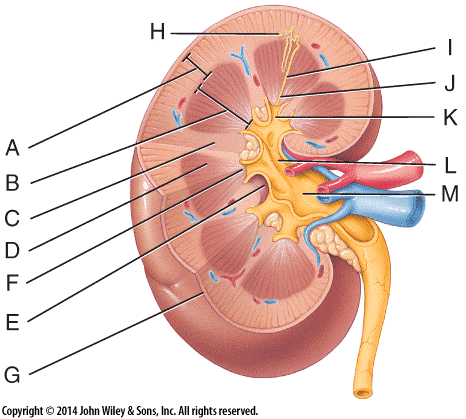
29) This can be divided into the cortical zone and the juxtamedullary zone.
- a) A
- b) D
- c) E
- d) F
- e) G
a

30) Each kidney can have anywhere from 8 to 18 of these.
- a) I
- b) J
- c) K
- d) L
- e) H
c

31) This structure is the apex of a renal pyramid.
- a) E
- b) D
- c) G
- d) K
- e) L
a

32) Urine formed by the nephrons first drains into these.
- a) H
- b) I
- c) J
- d) K
- e) L
d
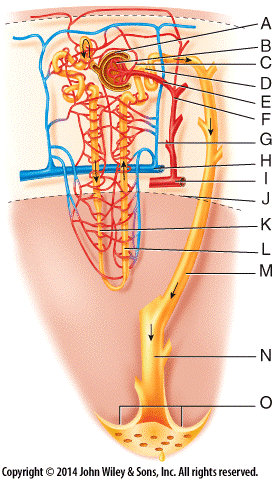
33) What two structures comprise the renal corpuscle?
- a) A and B
- b) C and D
- c) E and F
- d) K and L
- e) N and O
a

34) Where is the distal convoluted tubule?
- a) D
- b) E
- c) J
- d) K
- e) L
a

35) Where is the arcuate vein?
- a) E
- b) F
- c) G
- d) H
- e) I
d

36) Where is the ascending limb of the nephron loop?
- a) C
- b) D
- c) J
- d) K
- e) L
e

37) Where is the corticomedullary junction?
- a) G
- b) J
- c) M
- d) N
- e) O
b

38) Where is the papillary duct?
- a) C
- b) F
- c) H
- d) N
- e) O
d

39) What does line “M” point to?
- a) Arcuate artery
- b) Arcuate vein
- c) Collecting duct
- d) Descending loop
- e) Efferent arteriole
c

40) What is line “C” pointing to?
- a) Distal convoluted tubule
- b) Interlobular artery
- c) Efferent arteriole
- d) Arcuate artery
- e) Corticomedullary junction
c
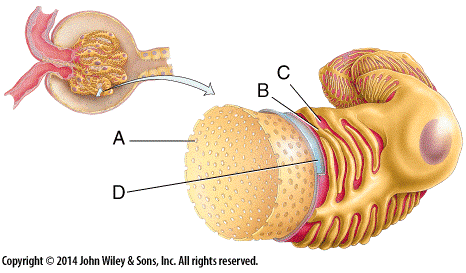
41) What is line “A” pointing to?
- a) Fenestration
- b) Pedicel
- c) Filtration slit
- d) Basal lamina
e) Lumen of the glomerulus
a

42) What is line “B” pointing to?
- a) Fenestration
- b) Pedicel
- c) Filtration slit
- d) Basal lamina
- e) Lumen of the glomerulus
b

43) What is line “C” pointing to?
- a) Fenestration
- b) Pedicel
- c) Filtration slit
- d) Basal lamina
- e) Lumen of the glomerulus
c

44) What is line “D” pointing to?
- a) Fenestration
- b) Pedicel
- c) Filtration slit
- d) Basal lamina
- e) Lumen of the glomerulus
d
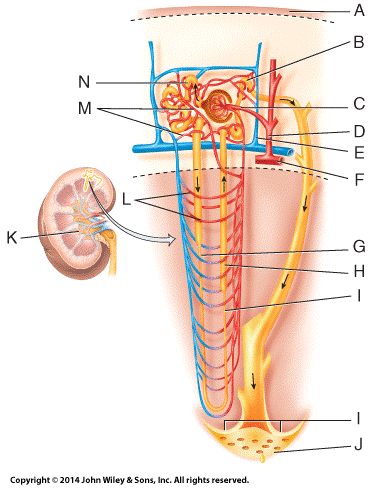
50) Fluid flowing from point N in the figure will go to which structure next?
- a) G
- b) H
- c) C
- d) B
- e) K
a

51) Fluid flowing from point G in the figure will go to which structure next?
- a) N
- b) H
- c) I
- d) M
- e) K
c

52) Fluid flowing from point H in the figure will go to which structure next?
- a) L
- b) B
- c) I
- d) G
- e) N
b

53) Fluid flowing from point B in the figure will go to which of the following structures?
- a) J
- b) M
- c) I
- d) G
- e) H
a

54) Which vessel in the diagram is the afferent arteriole?
- a) C
- b) D
- c) E
- d) F
- e) L
a

55) Which vessel in the diagram is the cortical radiate vein?
- a) C
- b) D
- c) E
- d) F
- e) L
c

56) Which vessel(s) in the diagram are the renal capsule?
- a) C
- b) D
- c) E
- d) M
- e) A
e

57) Which vessel in the diagram is the cortical radiate artery?
- a) D
- b) E
- c) F
- d) L
- e) C
a
58) If an individual goes on a crash diet and loses weight very rapidly, he or she will risk the development of
- a) kidney failure
- b) kidney stones
- c) nephroptosis
- d) a urinary tract infection
- e) bladder stones
c
59) Blood plasma and dissolved substances with molecules that are smaller than most proteins are filtered directly into the
- a) renal tubule
- b) collecting duct
- c) proximal convoluted tubule
- d) distal convoluted tubule
e) glomerular capsule
e
60) An increase in permeability of the filtration membrane due to disease, injury, or irritation of kidney cells by substances such as bacterial toxins, ether, or heavy metals manifests as which condition?
- a) albuminuria
- b) lucosuria
- c) urobilinogenuria
- d) ketonuria
- e) bilirubinuria
a
61) Anorexia, starvation, or a diet too low in carbohydrates manifests as which condition?
- a) albuminuria
- b) glucosuria
- c) urobilinogenuria
- d) ketonuria
- e) bilirubinuria
d
62) Stress, causing excessive amounts of epinephrine secretion which stimulates glycogen breakdown, manifests as which condition? This condition can also indicate diabetes mellitus.
- a) albuminuria
- b) glucosuria
- c) urobilinogenuria
- d) hematuria
- e) bilirubinuria
b
63) Excessive urine concentration of a normal breakdown product of hemoglobin, caused by pernicious anemia, infectious hepatitis, jaundice or cirrhosis, manifests as which condition?
- a) albuminuria
- b) glucosuria
- c) urobilinogenuria
- d) hematuria
- e) bilirubinuria
c
64) This substance gives bile its major pigmentation:
- a) ketone bodies
- b) erythrocytes
- c) casts
- d) bilirubin
- e) glucose
d
65) These are tiny masses of material, hardened in the lumen of the urinary tubule and are flushed out when filtrate builds up behind them:
- a) ketone bodies
- b) erythrocytes
- c) casts
- d) microbes
- e) urobilinogen
c
66) Candida albicans and E. coli are which type of abnormal constituent of urine:
- a) ketone bodies
- b) erythrocytes
- c) casts
- d) microbes
- e) urobilinogen
d
67) What is the normal pH range of urine in humans?
- a) 8.1 – 6
- b) 4.6 – 0
- c) 1.0 – 0
- d) 3.1 – 0
- e) 10.0 – 0
b
68) What is the normal volume of urine produced in humans?
- a) 1-2 L / hr
- b) 1-2 L / day
- c) 2-3 L / hr
- d) 3-4 L / week
- e) 10 L / 24 hours
b
69) What is the normal specific gravity range of urine in humans?
- a) 2.350 – 3.700
- b) 0.002 – 1.000
- c) 4.6 – 8.0
- d) 1.001 – 1.035
- e) 1.04 – 2.60
d
70) The parasympathetic division of the ANS regulates the flow of blood through the kidney
a) true
b) false
b
71) This hormone is released when the blood volume increases.
- a) Parathyroid Hormone
- b) Renin
- c) ADH
- d) Atrial Natriuretic Peptide
- e) Aldosterone
d
72) Consumption of salty food will cause an increase in this hormone.
- a) Aldosterone
- b) Renin
- c) ANH
- d) Angiotensin-II
- e) ADH
e
73) Absence of angiotensin converting enzyme will lead to
- a) decreased blood pressure
- b) increased blood pressure
- c) will not have any effect on blood pressure
- d) All of these choices are correct.
- e) None of these choices is correct.
a
74) In males, both the urinary system and the _________ use the urethra.
- a) integument
- b) reproductive system
- c) respiratory system
- d) digestive system
- e) cardiovascular system
b
75) The kidneys release _________ to raise blood pressure.
- a) renin
- b) angiotensin II
- c) ADH
- d) ANP
- e) epinephrine
a
76) The kidneys convert some of the bilirubin from hemoglobin breakdown to ________, a
yellow pigment.
- a) urobilinogen
- b) bile
- c) stercobilin
- d) urobilin
d
77) Shock wave lithotripsy is often used to treat which condition?
a) renal calculi
b) urinary tract infections
c) glomerulonephritis
d) polycystic kidney disease
e) urinary bladder cancer
a
78) Excessive calcium ingestion and low water intake can lead to which condition?
- a) renal calculi
- b) urinary tract infections
- c) glomerulonephritis
- d) polycystic kidney disease
- e) urinary bladder cancer
a
79) Inflammation of the kidneys is called
- a) cystitis
- b) nephrotic syndrome
- c) pyelonephritis
- d) urethritis
- e) glomerulitis
c
80) Some kidney diseases cause a change in the permeability of glomerular capillaries making them more permeable to plasma proteins. This changes the colloid osmotic pressure, thus drawing water out of the blood and into tissues. The result is
- a) dehydration
- b) edema
- c) overhydration
- d) high blood pressure
- e) there is no actual change
b
81) Another name for the glomerular capsule is _____ capsule.
- a) Cowper’s
- b) Skene’s
- c) Bartholin’s
- d) Bowman’s
- e) Brenner’s
d
82) What type of cells are found in the proximal convoluted tubule?
- a) simple squamous
- b) simple columnar
- c) simple cuboidal
- d) stratified squamous
- e) stratified cuboidal
c
83) The primary site for metabolic recycling is the
- a) liver
- b) kidney
- c) heart
- d) intestine
- e) spleen
a
84) Embryologically, the kidneys differentiate starting which week of development?
- a) first
- b) second
- c) third
- d) fourth
- e) fifth
c
85) As we age, several changes take place in the urinary system. These changes include
- a) shrinking of the kidneys
- b) decreased blood flow
- c) lower filtration rate
- d) greater urinary output
- e) increase in the number of glomeruli
a,b,c